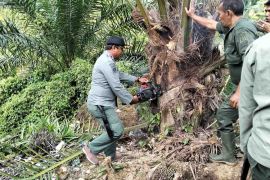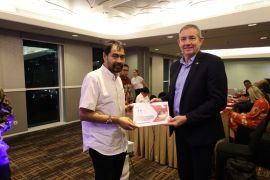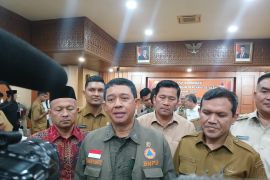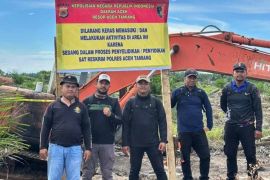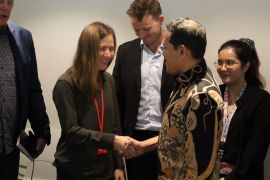It does not need music instruments but it produces harmonious sound, and it does not require a lot of space, but the dancers move very energetically, dynamically and with excellent coordination.
And more than that, the traditional dance in the past performed only by male dancers, conveys religious and noble messages.
The nation is even prouder now as the Saman dance is officially inscribed in UNESCO`s List of Intangible Cultural Heritage in Need of Urgent Safeguarding.
The United Nations Educational, Scientific and Cultural Organization (UNESCO) made the decision on the Saman dance at its Sixth Session of the Intergovernmental Committee for the Safeguarding of Intangible Cultural Heritage being held in Nusa Dua, Bali, from November 22 to 29, 2011.
"At the session, the Saman dance from Gayo Lues and environs in Aceh province was officially included in UNESCO`s List of intangible Cultural Heritage in Urgent Need of Safeguarding," I Gusti Ngurah Putra, a tourism and creative economy ministry spokesman , told the press on Thursday (Nov 24).
Coordinating Minister for People`s Welfare expressed his appreciation for the inclusion of the Saman dance in the intangible world cultural heritage list.
The recognition of the Saman dance by UNESCO should become the beginning of serious efforts to preserve and promote the saman dance, he said.
Education and Culture Minister Mohammad Nuh said at a press conference recently that the Saman dance was selected as a nominee because it was considered the most in need of an evaluation by UNESCO.
"We have of course studied a lot of cultural heritages and are wanting to register them. But, out of all the possibilities, the Saman dance was the most ready. Culture should not be dominated by Java, because other regions also have plenty of unique objects," the minister said.
Tourism and Creative Economy Minister Mari Elka Pangestu said the whole Indonesian community agreed the Saman dance urgently needed to be nominated for world cultural heritage status.
"It`s from the community, and it is in the most urgent need of recognition. We are worried that if it is not registered immediately, another nation may claim it as theirs," she said.
To prevent another country from claiming the Saman dance, the dance must be acknowledged, preserved, and promoted, she said.
The Saman dance was created by a Gayo tribe in the 13th century and later developed by Syeh Saman to convey religious messages. In the past, all Saman dancers were male and their number was always odd.
Boys and young men perform the Saman sitting on their heels or kneeling in tight rows. Each wears a black costume embroidered with colorful Gayo motifs symbolizing nature and noble values.
The leader sits in the middle of the row and leads the singing of verses, mostly in the Gayo language. These offer guidance and can be religious, romantic or humorous in tone.
Dancers clap their hands, slap their chests, thighs and the ground, click their fingers, and sway and twist their bodies and heads in time with the shifting rhythm in unison or alternating with the moves of opposing dancers.
These movements symbolize the daily lives of the Gayo people and their natural environment.
The Saman is performed to celebrate national and religious holidays, cementing relationships between village groups who invite each other for performances.
The frequency of Saman performances and its transmission are decreasing, however. Many leaders with knowledge of the Saman are now elderly and without successors.
Other forms of entertainment and new games are replacing informal transmission, and many young people now emigrate to further their education. Lack of funds is also a constraint, as Saman costumes and performances involve considerable expense.
During the Bali session chaired by Prof. Aman Wirakartakusumah of Indonesia, the Intergovernmental Committee decided that those elements satisfied the criteria for inscription on the List of Intangible Cultural Heritage in Need of Urgen Saferguarding.
Involving a community of not only players and trainers but also enthusiasts, prominent religious leaders, customary leaders, teachers and government officials, the Saman dance promotes friendship, fraternity and goodwill and strengthens awareness of the historical continuity of the Gayo people.
The Committee also sees that the Saman dance faces weakening informal and formal modes of transmission due to reduced opportunities for performance and the disappearance of the cultural spaces.
Despite the loss of important documentation on the Saman dance destroyed in the 2004 tsunami, the Banda Aceh Office for Safeguarding of History and Cultural Values submitted inventory data that was accepted in 2010 by the Directorate General of Cultural Values, Arts and Film of the Department of Culture and Tourism.
The Committee commended the Indonesian government`s efforts to ensure the widely inclusive participation of communities who suffered in recent years from great damage caused by the tsunami. It demonstrates the healing power of intangible cultural heritage and epitomizes the spirit of the Convention.
The Intergovernmental Committee comprises 24 member states elected by the General Assembly of States Parties to the 2003 Convention for the Safeguarding of the Intangible Cultural Heritage.
The members of the Committee are Albania, Azerbaijan, Burkina Faso, China, Croatia, Cuba, Cyprus, Czech Republic, Grenada, Indonesia, Iran, Italy, Japan, Jordan, Kenya, Madagascar, Morocco, Nicaragua, Niger, Oman, Paraguay, Republic of Korea, Spain, and Venezuela.
The Bali meeting is being participated in by around 500 representatives from 69 countries, NGOs, cultural experts and the media.
Apart from the Saman dance, others cultural heritage inscribed by UNESCO in the List of Intangible Cultural Heritage in Need of Urgent Safeguarding in the Bali meeting are Folk long song performance technique of Limbe performances - circular breathing from Mongolia; Hezhen Yimakan storytelling of China; Moorish epic T`heydinn of Mauritania; Naqqali, Iranian dramatic story-telling of Iran; Traditional skills of building and sailing Iranian Lenj boats in the Persian Gulf of Iran; Xoan singing of Phu Thá» Province of Viet Nam; and Yaokwa, the Enawene Nawe people`s ritual for the maintenance of social and cosmic order of Brazil.
Previously, Indonesia`s cultural heritage which have included in UNESCO`s Representative List of the Intangible Cultural Heritage of Humanity are Angklung bamboo music instrument (2010), Batik traditional textile (2009); Kris blade and Wayang Puppet Theatre (2008).
In 2012, Indonesia plans to nominate Noken from Papua, a Balinese dance, and the Beautiful Indonesia in Miniature Park (TMII) to be included in the UNESCO`s list of intangible world cultural heritage. (*)
Reporter: By Fardah
Editor: Kunto Wibisono
Copyright © ANTARA 2011
